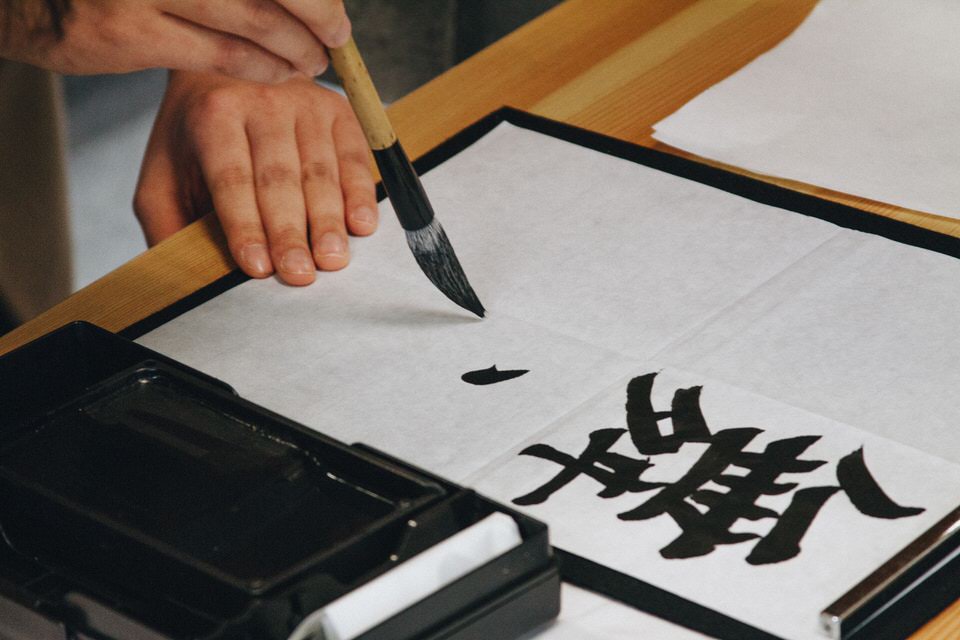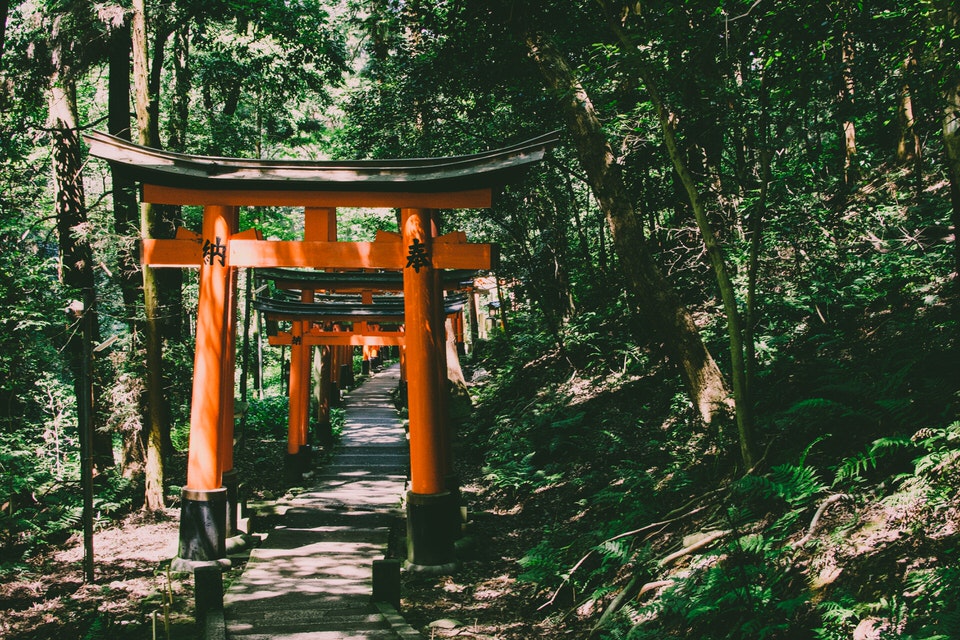Suicide is an inescapable part when it comes to thinking Japanese culture and society.
Japan has one of the highest suicide rates in developed countries with a particularly high tendency for young people to commit suicide.
But is the suicide rate really that high in Japan? If so, what kind of cultural and social structures in Japan are responsible for the high suicide rate?
Sorting out the data on the suicide rate may shed some light on the matter.
Japanese suicide rates compared to the world
Let's start with a comparison of suicide rates around the world.
This is the 2017 data from Our World in Data. How high is the suicide rate in Japan on an international scale?
This map shows the suicide rate per 100,000 people per year, and this shows that Japan is at the same level as countries such as India, Mongolia, Belarus, Central African Republic, Eritrea, Mozambique, and Uruguay.
But It has to be considered that some countries have different economic conditions, some are affected by the cold climate, and some are affected by political instability.
Therefore, the following data will be compared the suicide rates in the G7 countries.
Japanese suicide rates compared to other G7 countries
This is the suicide rate comparison within G7 countries.
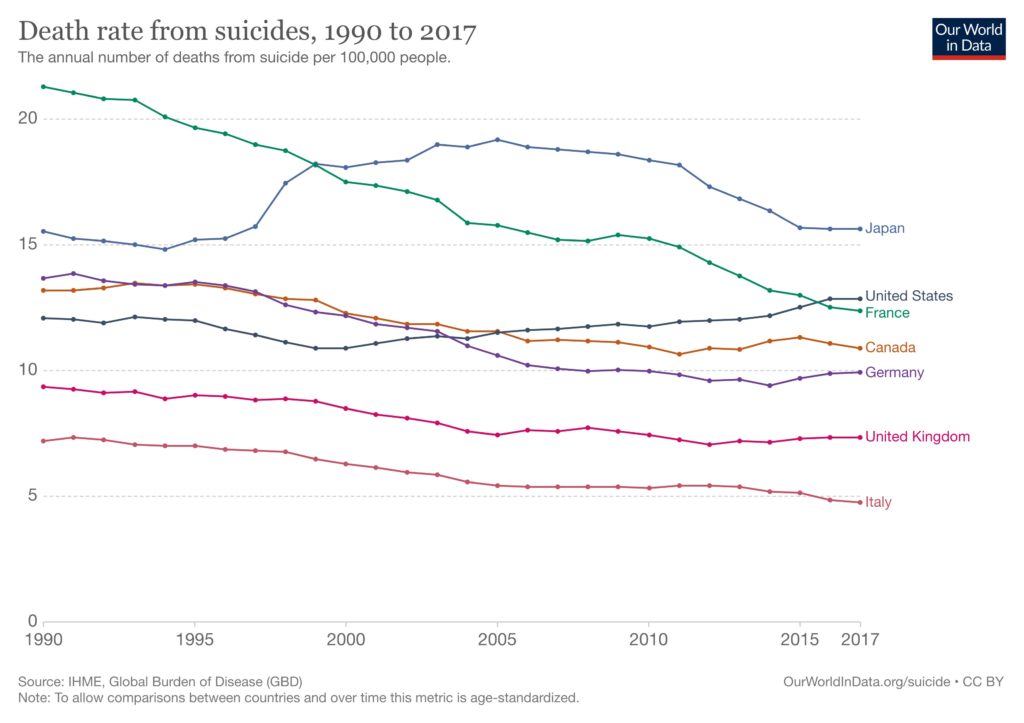
In Japan, the suicide rate started to rise rapidly around 1998, and has been gradually decreasing until now.
However, compared to other G7 countries, it can be said that the suicide rate is still high.
According to the Ministry of Health, Labou and Welfare, the data shows that mortality rate is higher than that of other countries.
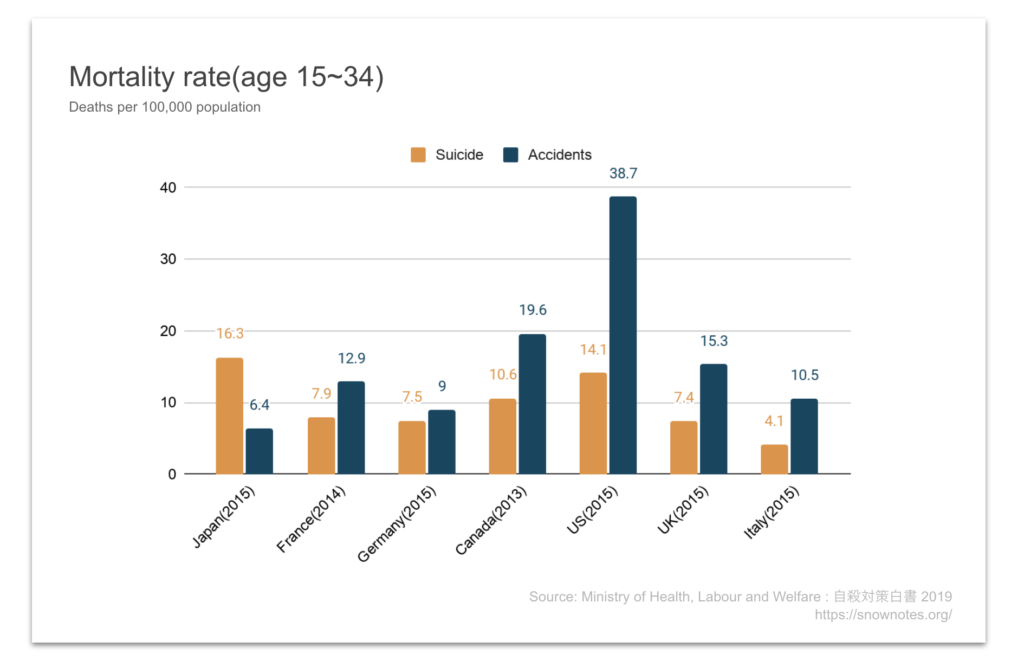
and this is very shocked that suicide among the younger generation is a serious situation.
This is the age group and percentage composition by cause of death in 2017.
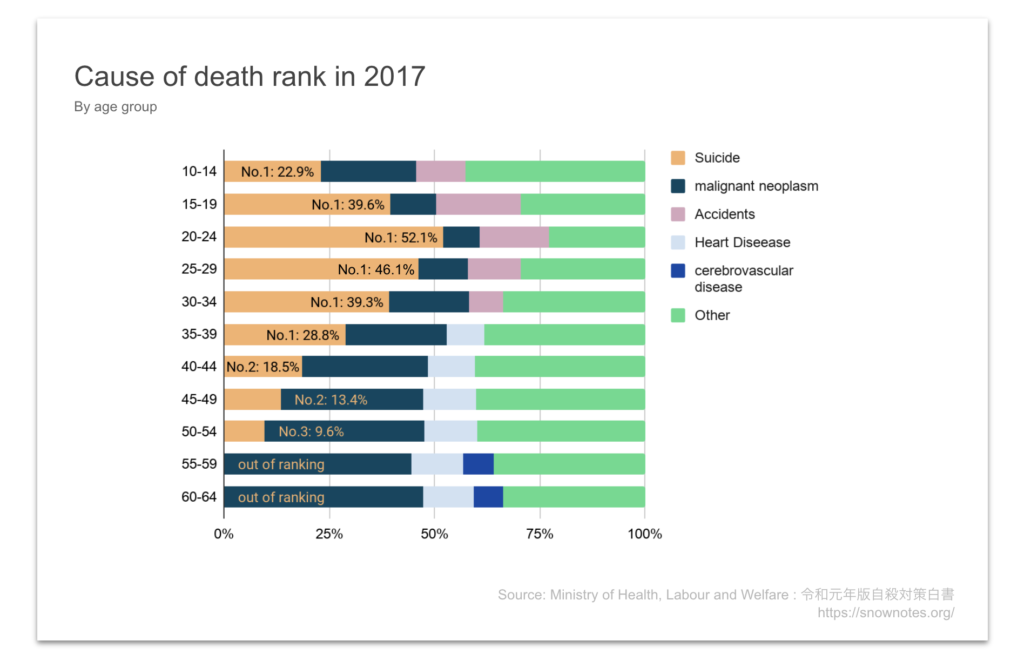
As the graph shows, suicide is the leading cause of death for people between the ages of 10 and 39.
Japanese suicide rates Detail
The National Police Agency publishes statistics on the suicide rate. following graphs are created based on the statics.
Japanese suicide rates by gender
This is the graph of annual change in suicides.
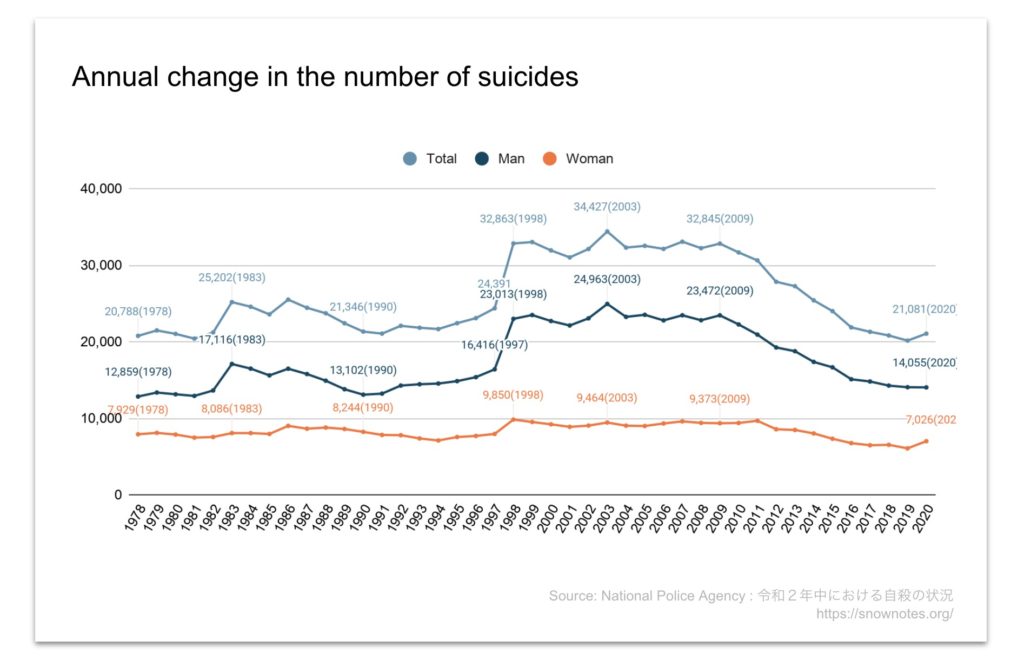
As the previous graph shows, the number has increased rapidly in 1998, and the graph also shows that the suicide rate has rised mainly among man.
Impacts of Covid-19?
These days, The news also cites an increase in the suicide rate among women and the suicide rate has risen for the first time in 11 years.
Some news article shows that Covid-19 changed the way people live and this change has impact to woman.
- Covid and suicide: Japan's rise a warning to the world?(18 Feb, 2021)
- In Japan, more people died from suicide last month than from Covid in all of 2020. And women have been impacted most(November 30, 2020)
- Pandemic raises Japan suicide rate after decade of decline(Jan 22, 2021)
Japanese suicide rates by age
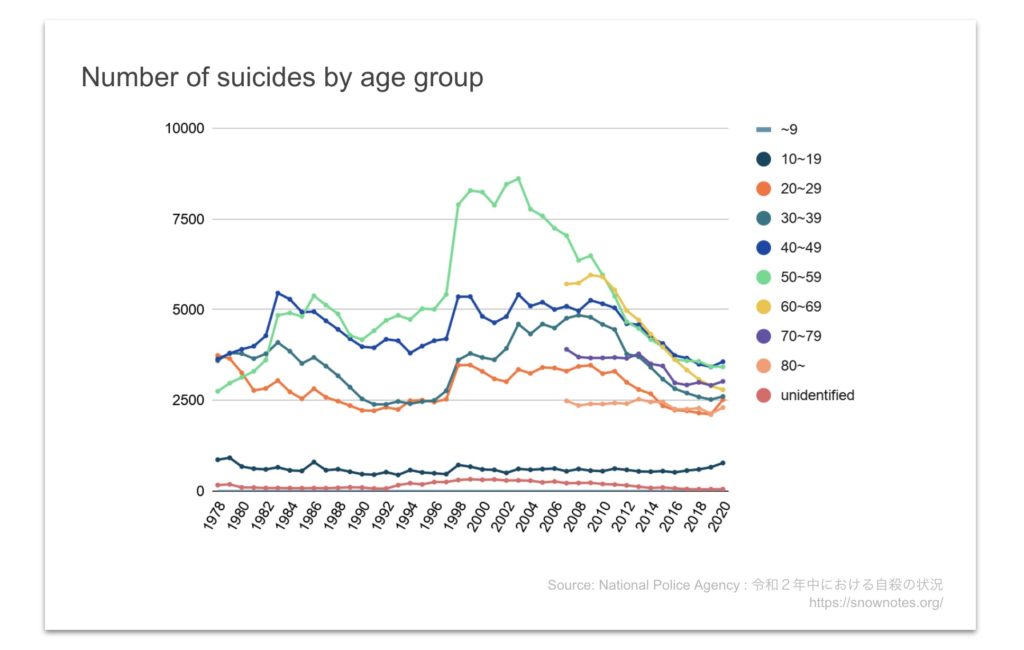
By age group, the increase in the number of suicides among working-age men in the 40s and 50s was particularly serious.
In the article of Nippon.com, Takashi Amakasa, a psychiatrist, cites the following three factors behind the increase in suicides among working-age men.
- As the recession worsened in the 1990s, a lot of companies were not able to maintain lifetime employment. With deteriorating business performance, employee layoffs have become a real problem.
- In the midst of the recession of the 1990s, the seniority-based wage system was replaced by a performance-based system.
- Increase in part-time employment: Part-time employment also began to increase in the 1990s.
In Japan, the common name for the 20 years of economic stagnation that followed the bursting of the bubble economy from the early 1990s to the early 2010s is "lost two decades in Japan" (失われた20年).
Causes of Suicide in Japan (2020)
the causes and background of suicide are divided into six categories in the material of the National police Agency.
The data also states that most suicides have diverse and complex causes and backgrounds, and occur as a result of a chain of factors.
This is number of people each type of problems. (Up to three causes and motives that can be clearly inferred from suicide notes and other supporting documents can be recorded for each suicide)
| Health problems | 10195 |
| Family problems | 3128 |
| Work fatigue problems | 1918 |
| School problems | 405 |
| Relationship problems | 799 |
| Economic problems | 3216 |
| Others | 1221 |
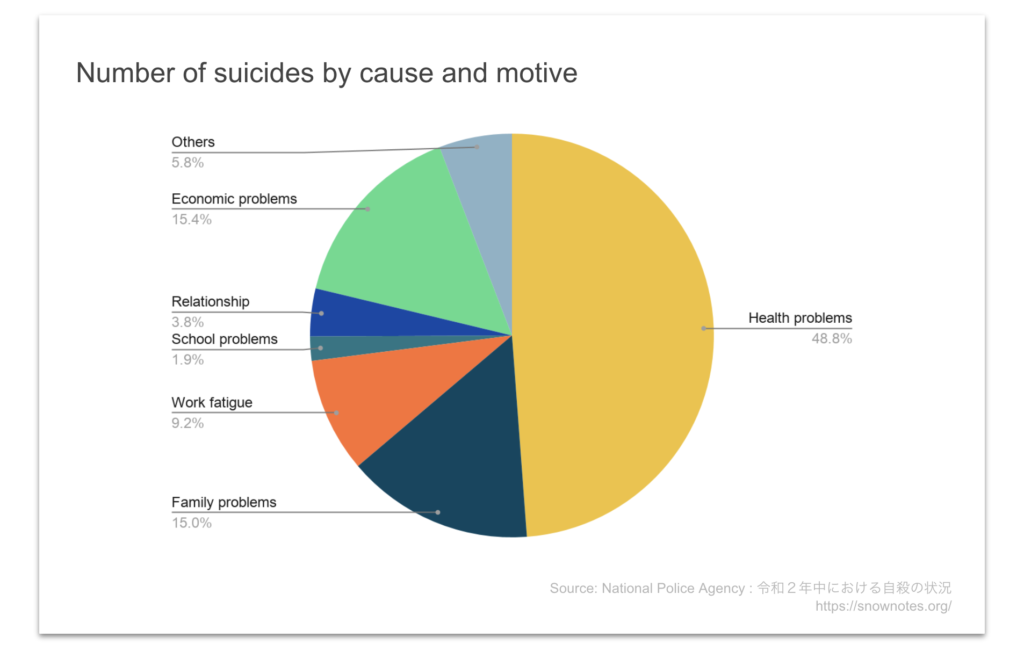
Health problems
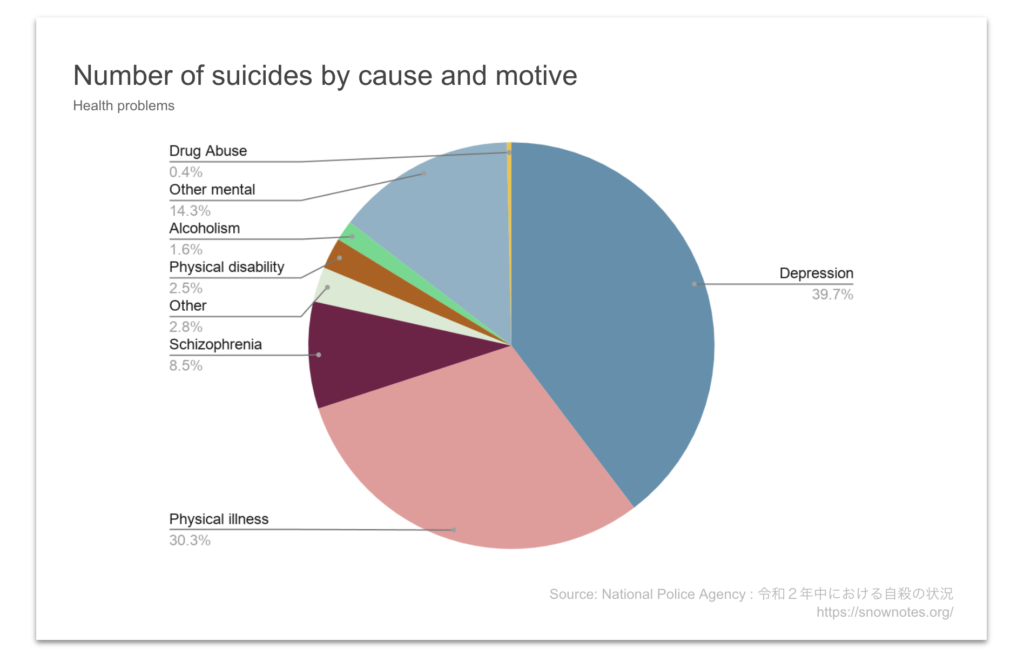
Here is a breakdown of the suicide rate for health problems.
The majority of suicides are due to depression and physical illness.
Depression
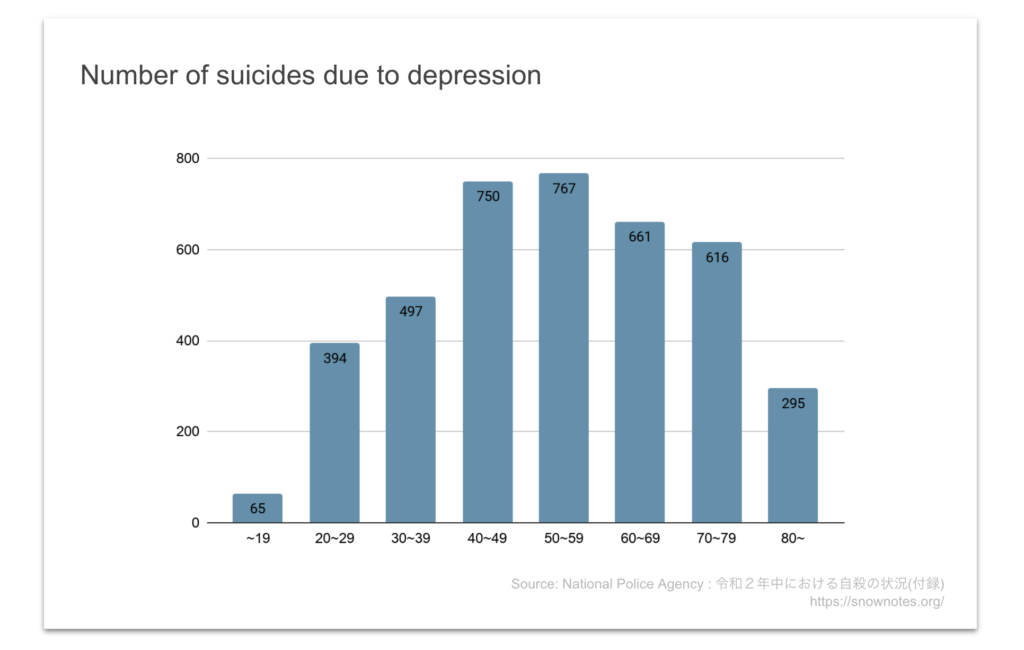
Health problems account for the largest share of the suicide rate, with depression accounting for the largest share of those health problems.
The graph shows that the number of suicides due to depression is particularly high among middle-aged and older people.
However, there is a complex set of factors when it comes to what causes depression. There are many hidden causes of depression, such as family problems, poverty, and work problems.
Physical illness
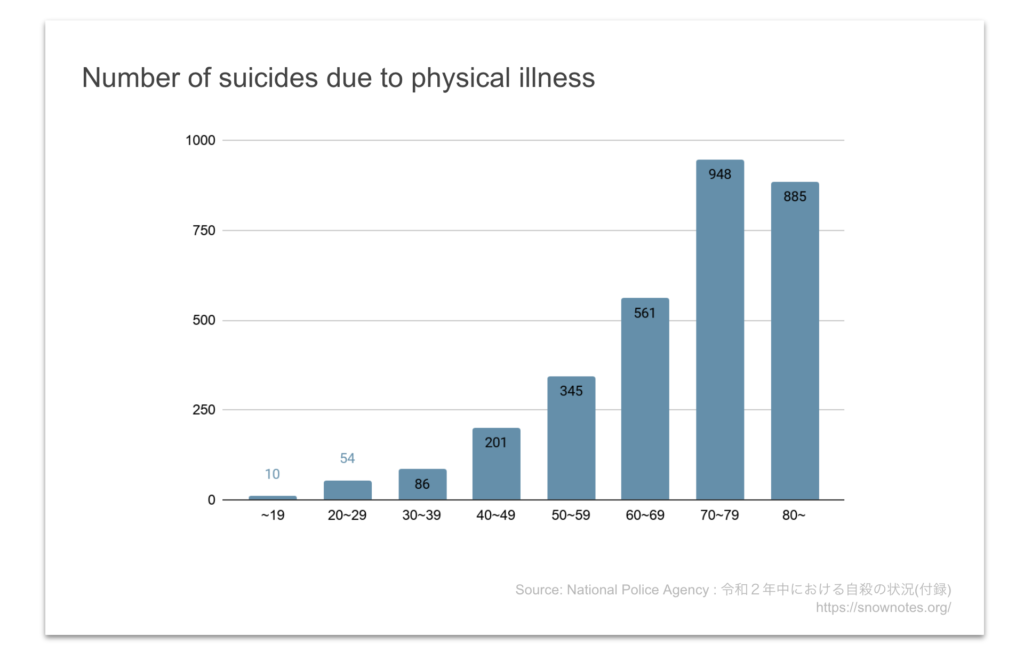
Looking at the age breakdown of suicides due to physical illness, another major factor, the graph is tilted more toward the elderly.
Considering the fact that society will be moving towards an aging society in the future, it will be very important for Japanese society to consider suicide prevention among the elderly.
Family Problems
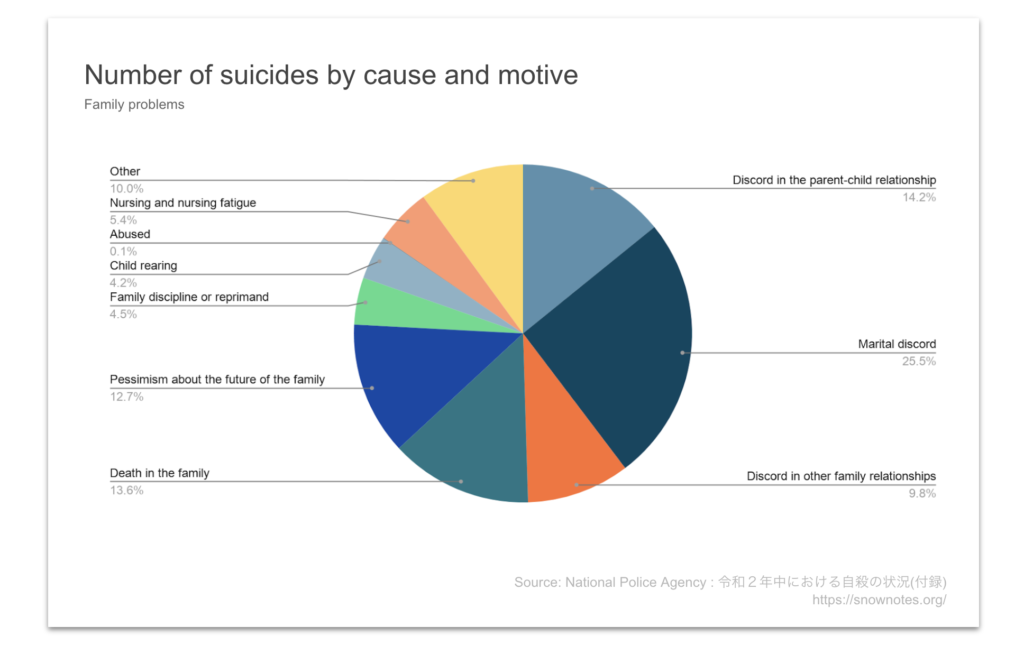
Here is a breakdown of the suicide rate for family problems.
Work problems
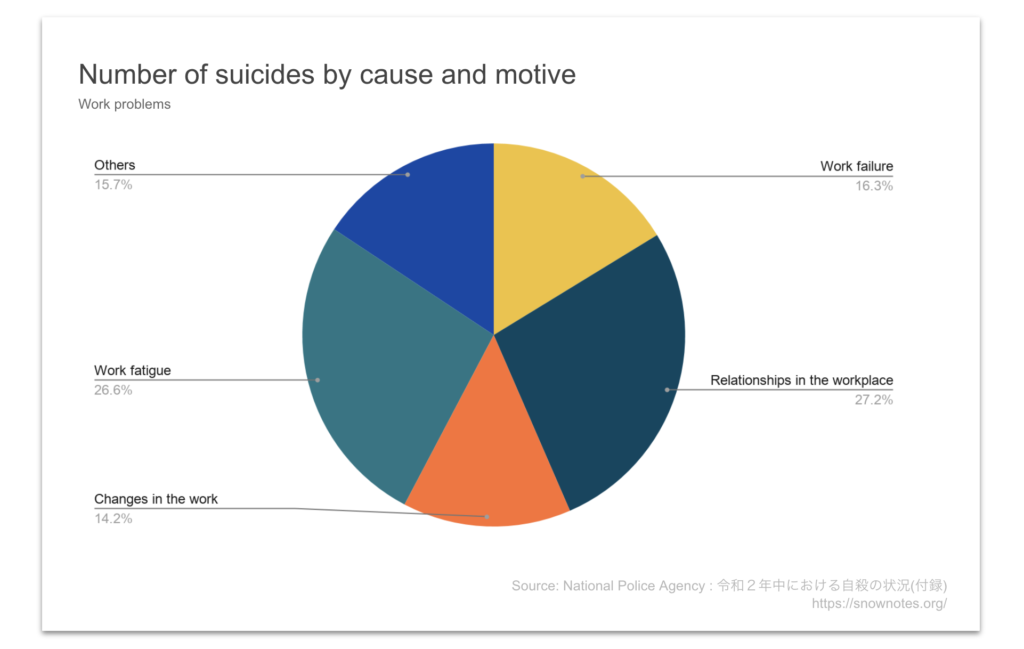
Here is a breakdown of the suicide rate for work problems.
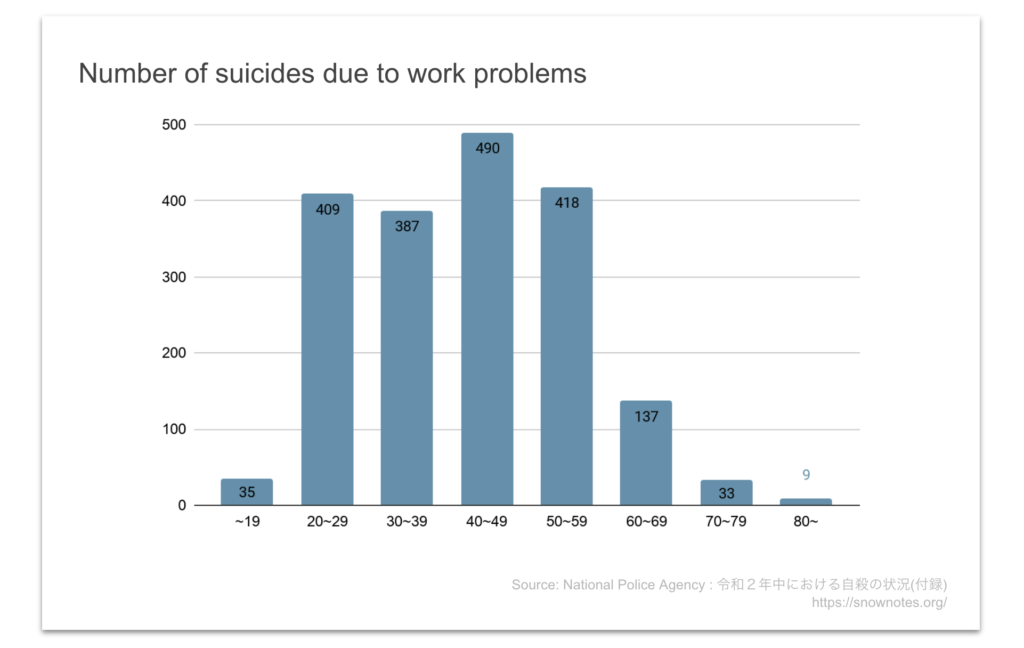
Looking at the breakdown by age group, young people in their 20s and other age groups have the same percentage here as the elderly group.
Karoshi (過労死)
Karoshi (過労死, Karōshi), which can be translated literally as "overwork death", is a Japanese term relating to occupational sudden mortality. The most common medical causes of karoshi deaths are heart attacks or strokes due to stress and a starvation diet. Mental stress from the workplace can also cause karoshi through workers taking their own lives. People who commit suicide due to overwork are called karōjisatsu (過労自殺).
Wikipedia
You may have heard the term "Karoshi". Karoshi means overwork death and this is a big problem in Japanese work culture.
School problems
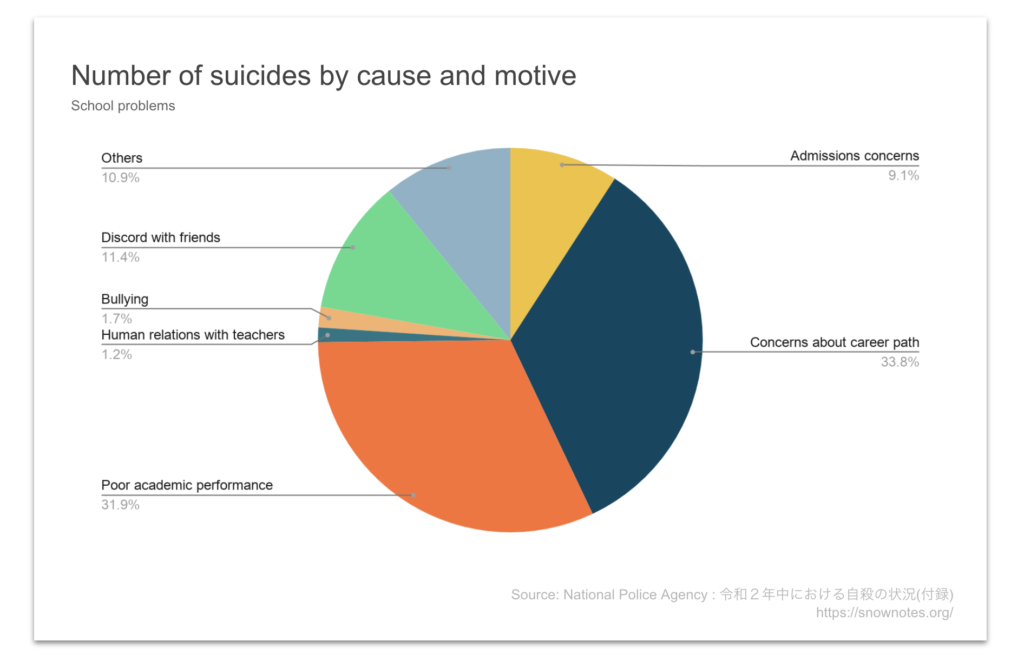
Here is a breakdown of the suicide rate for school problems.
Relationship problems
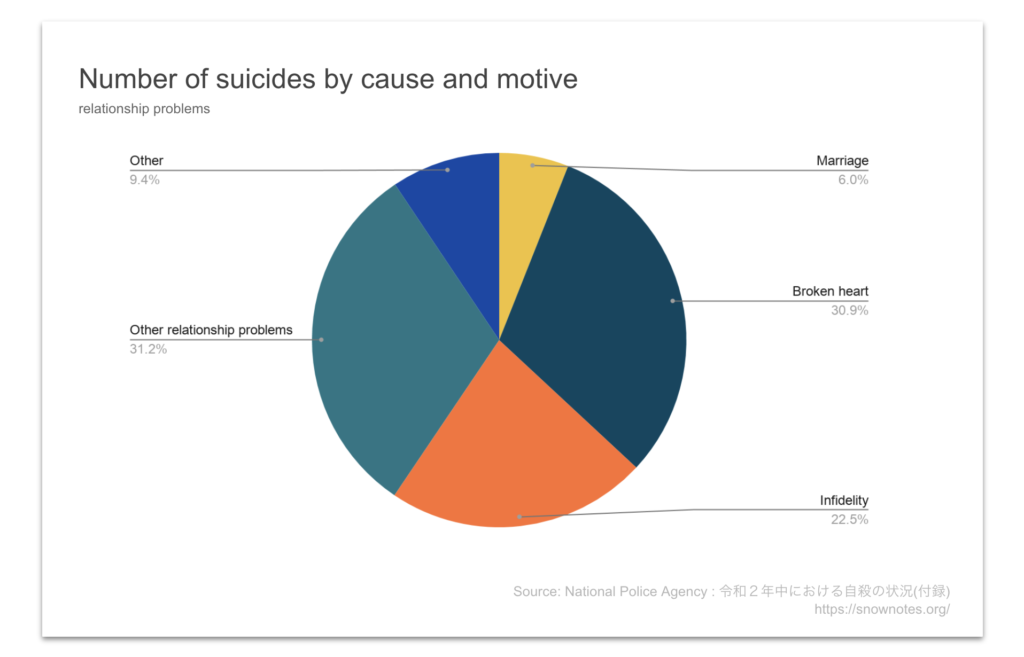
Here is a breakdown of the suicide rate for relationship problems.
Economics problems
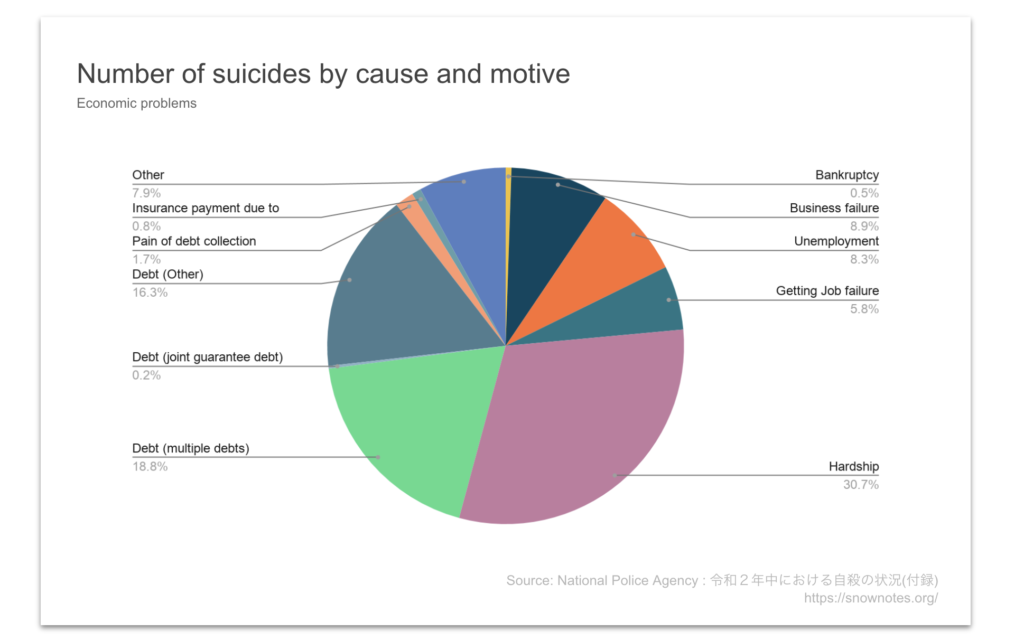
Here is a breakdown of the suicide rate for economic problems.
Impacts of technology
With the development of technology, the situation regarding suicide is also changing.
Internet suicide / Suicide inducement
The meaning of "Internet suicide" is that suicidal people meet each other through suicide-related websites on the Internet and commit mass suicide.
This is a new problem since internet is invented and people who have same value are easily connect each otner (in a good way / bad way).
Cyberbullying
Defamation on social networking sites has also become a major issue.
In particular, this issue has become a major concern in Japan as Hana Kimura, a professional wrestler who appeared on popular TV's program, "Terrace House," commit suicide due to abuse on SNS.
Learn more about Japan
You can learn more about Japan here:
Japanese Culture : Everything you need to know
Here's the summary of Japanese culture that you need to know. Hope this article helps you to find new interest and chance to deep into Japanese culture.



